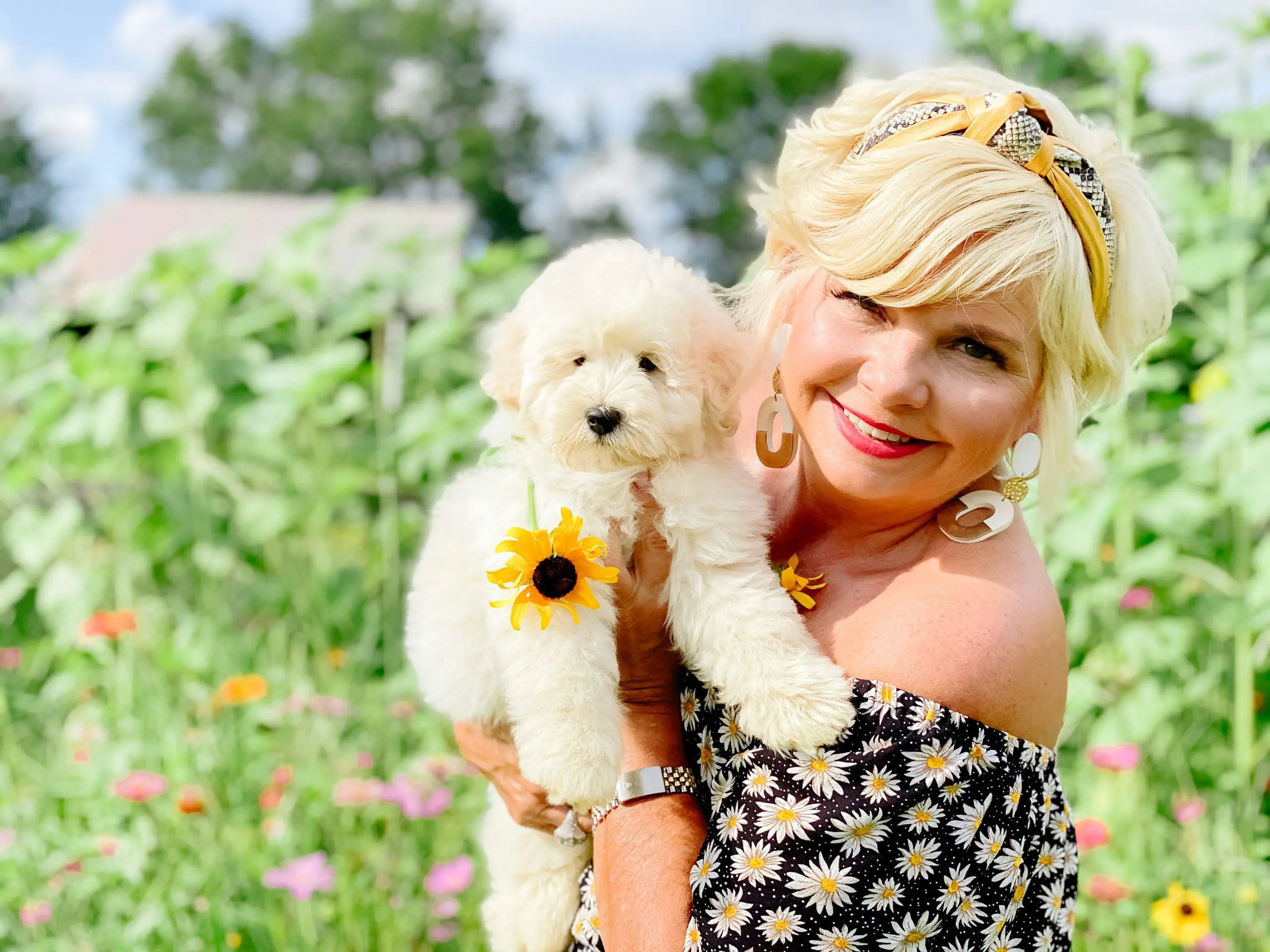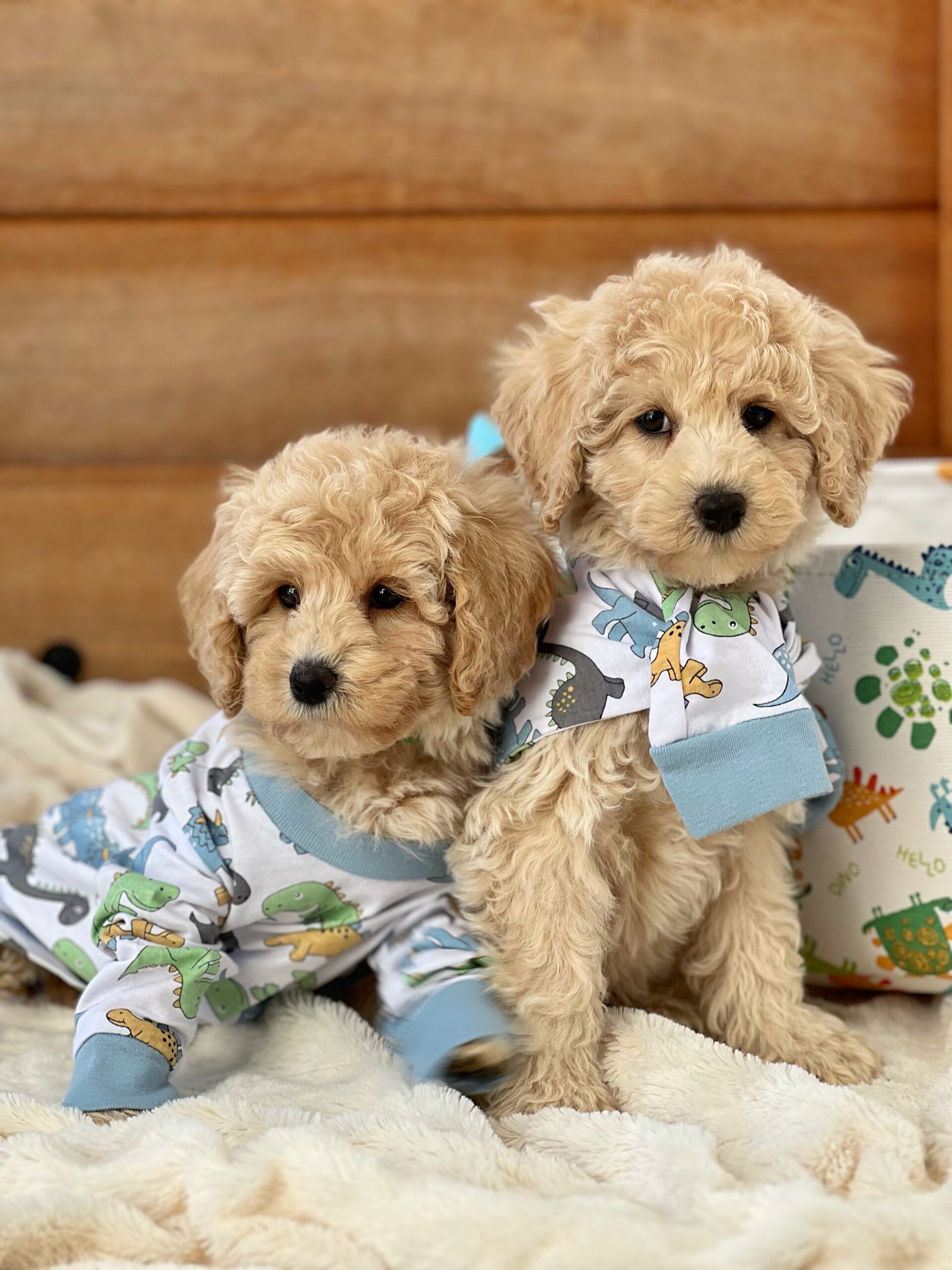A dog’s temperament, it’s a lot like a human’s Personality.
A dog’s temperament is influenced by various factors, such as genetics, training, and socialization. However, a dog’s environment, socialization, and daily routine can have a more significant impact on their behavior than heredity alone.
English Goldendoodles are known for their loyal and easy-going nature, making them an excellent choice for inexperienced dog owners. They are highly intelligent and respond well to training. Both Poodles and Retrievers were originally bred as working dogs, specifically for retrieving hunting kills without damaging them. Therefore, Goldendoodles are likely to have a natural instinct to fetch and please their owners, making them excellent companions for families or individuals who enjoy outdoor activities.
The all-around BEST word to describe our English Goldendoodle would have to be friendly. They love everyone.
They shower everyone they meet with affectionate, sloppy kisses, and expect lots of belly rubs in return.
Our puppies are raised by our around-the-clock Doodle-loving staff. They are exposed to many different types of people coming, going and interacting with them to develop their socialization skills. They are very kid-friendly, gentle with children and sturdy enough to handle heavy-handed pats and hugs. This is why they make such wonderful therapy, service, companion and facility dogs.

Friendliness toward dogs and friendliness toward humans are two completely different things.
Some dogs may attack or try to dominate other dogs even if they're loving and sweet with people. Some would like to play instead of fight, and some will turn tail and run.
Research shows that dogs who lived with their littermates and mother until at least 6 to 8 weeks of age and who spent lots of time playing with other dogs during puppyhood are more likely to have good canine social skills.
Our puppies are all assessed each week for socialization progress. If we see a dog-aggressive puppy we immediately begin working on those negative behaviors while they are still with their littermates.

Please keep in mind that all dogs are individuals. While we can’t guarantee how any puppy or dog will behave, these generalizations are based on our past experiences.

Temperament Rules. What’s Yours?
It’s very important to find a dog that matches the temperament of you and your family. They can at times be sensitive dogs, and they have a strong desire to please their people. It is always better to focus on getting the right temperament puppy for your family over color or gender. A pretty face won’t matter much if you and your puppy do not work well together.
Low-sensitivity dogs, also called “easygoing,” “tolerant,” “resilient,” and even “thick-skinned,” can better handle a noisy household, a louder or more assertive owner, and an inconsistent or variable routine. The more physical the dog’s lifestyle is the less crazy their behavior will normally be at home.
Have young kids? Throw lots of dinner parties?
Play in a garage band? Lead a hectic life?
Go with a low-sensitivity dog. We can tell early on which puppies in the litter are low-sensitivity and which ones are high-sensitivity. It is our desire to match our puppies with the family that is THE best match for you. Our RULE is that “Temperament RULES” !!!
English Goldendoodles LOVE to be with their families, and they don’t love being left alone for extremely long periods of time. An anxious dog can be very destructive; barking, whining, chewing, and otherwise causing mayhem. They are most happy when a family member is home during the day or if they can go to work with you. If they need to be home all day alone, coming back around lunchtime to let them out and give them a pat on the head really helps. Sometimes leaving the TV on can help ease their anxiety. Our dogs like Animal Planet, or any shows with lots of people.
Goldendoodles can tolerate both cold and hot weather very similar to humans. They have a nice coat as well as an undercoat that covers an ample amount of body fat.
They LOVE cold weather and can tolerate warm weather. They will need to stay indoors with you on hot or humid days, and you’ll need to be extra cautious about exercising your doodle in the heat. They love swimming and retrieving and are very agile (for a limited period of time). They go hard quickly and they fizzle out just as fast.
Temperament in Puppyhood
Your puppy will pass through many stages as he grows and develops. Many puppy owners are shocked, surprised or downright freaked out about the way their cute little puppy is behaving. Knowing what stage of development your puppy is experiencing helps explain a lot. Behaviors can be accounted for with these stages, but some of these behaviors are not acceptable and you must lead the way.
The mother of your puppy starts the training process. It will then be turned over to you. We cannot express enough how important is for you to train your puppy to be a happy, well-adjusted member of your family for life. We STRONGLY recommend that all puppies enroll in our Doodle Prep School prior to coming home, to ensure that your puppy gets the foundational training they need.
During the toddler period, Doodle puppies emerge on their own from the litter. They venture into the surrounding environment. These lessons learned in the toddler stage are CRITICAL. Puppies removed too early tend to be nervous, tend to bark a lot, and tend to bite. Training problems and long-term behavior problems can often be attributed to a puppy removed from the litter much too soon.
• First lessons learned are dog-specific behavioral patterns:
• They will learn various postures’ meanings and their effects to their mother and littermates.
• They will learn how to bite and what it is like to be bitten.
• They will learn what barking and other vocalizations mean and their uses.
• They will learn how to establish social relationships with other dogs.
• Vocalization and tempered activities (dog manners) usually are learned.
• They will learn how to be submissive to the leader.
• They will learn and refine additional postures, vocalizations, and acceptable dog interaction behaviors.
The mother will growl, snarl and snap to communicate. With a few very clear signals and repetitions, the young puppy will learn quickly. At that point, a mother’s glare or low growl is all that is needed to keep a young pup in line. Littermates also learn clear signals of communication to each other
Dogs that are denied socialization during this critical Socialization Period often become unpredictable because they are fearful or aggressive. It is during this time that your dog needs to have positive experiences. They need to be introduced to new things and begin the groundwork to a happy, well-adjusted dog.
• Puppies have short attention spans.
• Things learned are permanent and will be resistant to change.
• Puppy will be eager to learn.
• What he does and learns now, he will do as an adult.
• Puppy’s temperament and personality will become more apparent.
• Puppy will be transitioning his education from his mother to his human environment.
Beginning at 8 weeks and ending at approximately 11 weeks of age any traumatic, painful or frightening experiences can have a lasting impact.
• Gradually introduce your puppy to new things, environments and people.
• Make experiences positive (provide treats or toys).
• Don’t push your puppy into fearful situations – take things slowly and allow him to adjust and get used to the situation.
• Do not let others push your puppy or be forceful with them.
• Provide a secure comforting demeanor.
• Teach the puppy you are there to protect and lead.
Your puppy has been in the home now for a few weeks, watching you and the family very closely. He is picking up on human behaviors and reactions. He is learning the pecking order of the pack.
As he observes and learns, he will then attempt to figure out where exactly he stands in the pack order and also see if moving up in the pack will work. After all, he knows who the “weak links” are and will start at the bottom and try to move right up the pack. How could such a cute little pup be such a pistol?
• Puppy will begin to question authority.
• Puppy will attempt to move himself up in the pack order.
• Puppy will try to dominate.
• Puppy will grab leashes
• Puppy will try to determine what activities are going to be done and when.
• Puppy may growl.
• Puppy may put his mouth on you.
• Puppy can often become over-excited.
• Learn how your actions and body language communicate to your dog.
• Do not play aggressive games during this phase (tug or wrestling).
• If the puppy becomes over excited, growls, or mouths you – stop all activity.
• Be very aware of how the puppy interacts with children – do not leave children unattended with the puppy.
Your cute little puppy has been following you around for weeks now, and has stayed pretty close. During this period, that same cute little puppy will decide that he is ready to go solo and take off. Teaching the puppy that he must stay close by or come when called is critical. The failure to do this will result in a dog that will not be reliable to come or to stay close by as an adult and very well could lead the dog into a life or death situation.
• The puppy will become more independent.
• A puppy that previously would never go very far will venture off.
• The puppy will ignore commands to stay close or come.
• How you handle refusal to come or stay will affect future reliability off-leash.
• Puppy will be clever in attempts to run around you.
• Leash on 100% of the time they are not in a confined area.
• Never allow dog loose in an unconfined area (Yes, this is redundant to the above, so it must be pretty important for us to say it twice).
• Being off-leash outside of a confined area is reserved for those who have been well trained.
• Enroll in a training class that utilizes positive training techniques.
• Reinforce and continue to train your puppy the “come” command.
• Make coming to a very positive experience.
• Oh… and never allow your puppy to be off-leash in an unconfined area.
Adolescence Period (7 – 10 months)
This is one of the most difficult times for pet owners when their cute puppy turns into “devil dog” or “Cujo”. This often is a time when many families start to worry that maybe they made a bad decision in getting a dog. Remember: you get what you put into it. If you take the time right now to teach good habits, you will have the dog you always dreamed of for many years. This work will pay off.
• The puppy will become a free and independent thinker.
• The puppy will continue to review the pack order.
• The puppy will be very energetic.
• The puppy will be exuberant and enthusiastic.
• They turn into clowns with teeth.
• They will delight in learning new and fun things.
• Appreciate the humor of it all.
• Have you read the book The Dog Listener yet? It will help.
• Understand that despite the behaviors, it is your time to continue to train and reinforce the things you do want him to do.
• Reaffirm the family pack order.
• Be realistic about expectations (still very much a puppy in a big boy body)
• Channel all that energy into positive learning experiences.
• Continue with training classes; explore options for additional training opportunities.
You have a puppy that is full of beans — he runs around like a clown in search of his next show. But then… BAM! He’s afraid to walk down some stairs, he’s shaking nervously in the car, or he jumps at the sound of the neighbor’s music.
Surprise! This is normal, but you must help your dog figure out how to deal with his fears or concerns. The skills of learning how to “shake it off and keep going” will be valuable to him for the rest of his life. It will also reduce the chances that the things he fears will not be permanently imprinted for life.
• Your puppy that was so confident will suddenly become reluctant to new things.
• Fears may come and go several times over this entire period.
• It may appear to be unprovoked or unrelated to any specific occurrence.
• You may get more frustrated than usual with your puppy.
• You may notice this behavior more in males.
WHAT YOU CAN DO:
• Avoid extremes in your response (no anger or forcing or over comforting)
• Be patient and understanding.
• Be aware of surroundings and potential triggers.
• Work on desensitizing him with gradual introductions with rewards.
• Avoid too much reassurance or coddling (which is a reward for this behavior)
• Don’t overreact or correct the fearfulness – just make light of it and encourage him to deal with his fear (work through the fear)
• Praise with grand rewards for his attempts.
• Your dog will take his clues from you — if you act frightened or concerned he will, too.
So, your puppy is no longer a baby. He is pretty much fully grown in height. He will begin to fill out a bit and develop more muscle tone. But mentally the dog is still working out some last details of his life and what it means to him.
He is a member of a pack and now begins to find that his turf is worthy of monitoring and protecting. Sort of sounds nice to have your dog be protective, but don’t fall for it.
You do not want your dog to take over these responsibilities, because soon you too will be under the rule of the King Dog. This can lead to aggressive behaviors, protective to the point of creating fear or actually harming someone or another animal as he protects. This is bad news and often a reason a dog is taken out of the home. So, don’t allow your dog to be the King of the Castle. Assign him the role of court jester – he will be happier and so will your family
• The dog may become more turf protective.
• Strangers may be greeted with barking.
• Barking at noises, birds, cars, butterflies, pretty much everything he believes is worthy of attention.
• Playing with other dogs may escalate to fighting.
• Same-sex confrontations of other dogs can occur.
• Once again, checking the pack order to see if he can move.
WHAT YOU CAN DO:
• Reinforce how to greet strangers into your home.
• Teach your dog to ignore dogs he cannot be nice too.
• Practice or reinforce dog manners (utilizing non-threatening dogs)
• Learn to read your dog and other dogs. (Circling, walking on toes, stiff tail wags, tense facial expressions are the signs of aggressive behaviors)
• Rally your family to review that the pack order is clear and everyone is consistent with training and corrections.
• Reward him for good behaviors.
• Give that dog another job, therapy work, obedience classes, ag